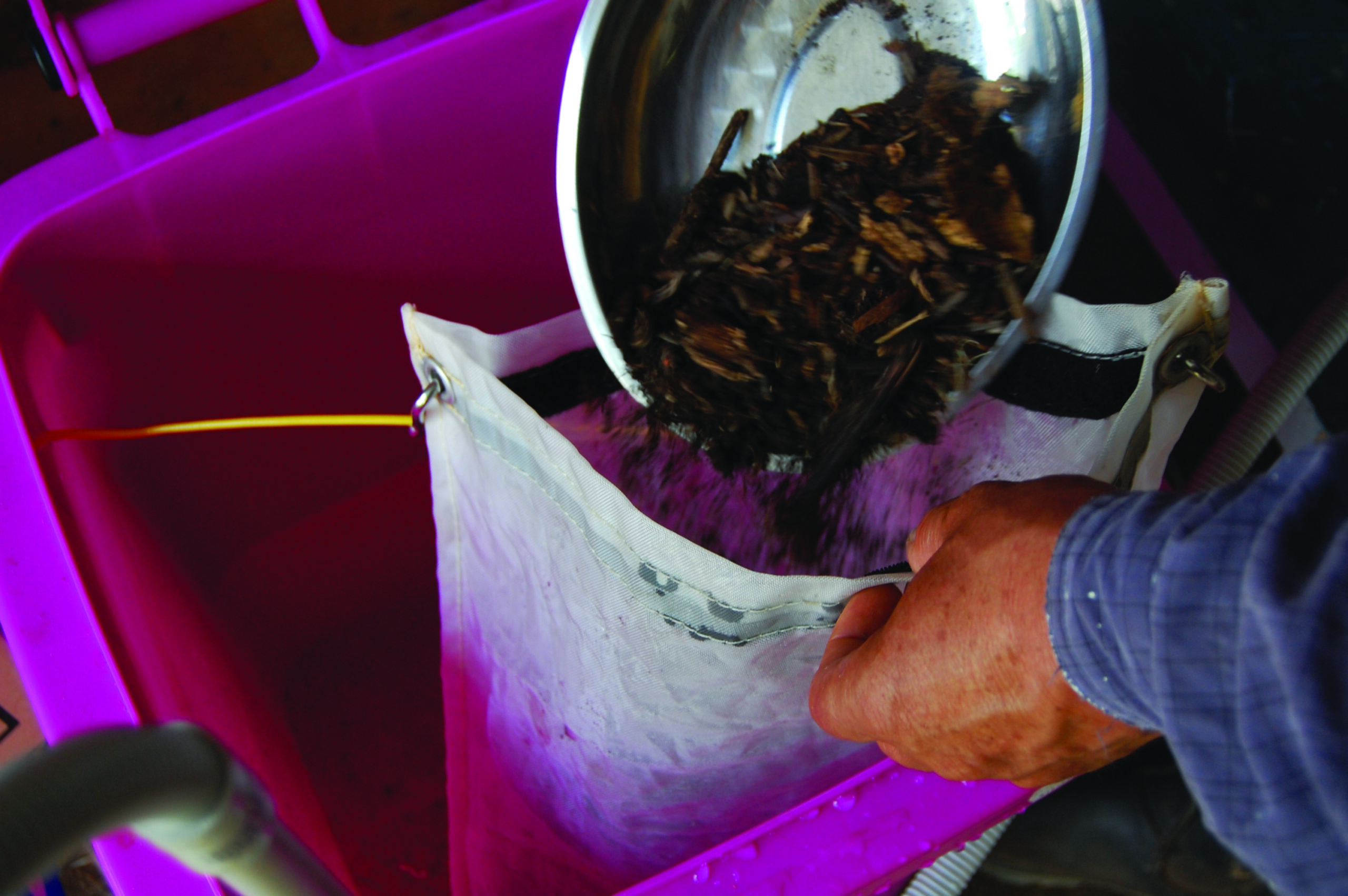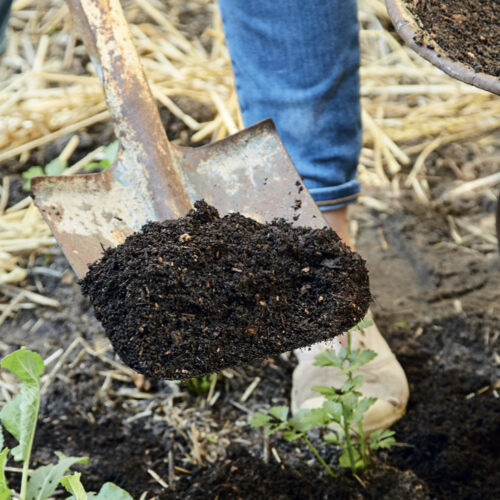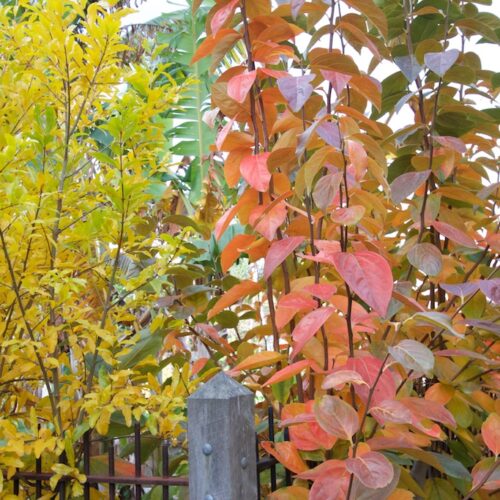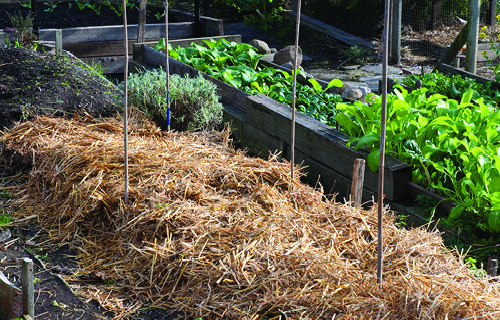How to make compost tea
2013-07-31T06:49:02+10:00
In the March/April 2012 issue of Organic Gardener magazine, SIMON WEBSTER investigates how to make a successful brew of compost tea: the essence of organic farming and gardening. Plus he provides a step-by-step guide to building your own brewer.
Food growers have long added nutrients to their gardens by soaking manure or compost in containers of water and pouring the resultant brew on their plants. But according to soil microbiology expert Dr Elaine Ingham, this traditional method of making “compost tea” can produce mixed results, particularly in terms of the vital microbial life the liquid contains. Dr Ingham, chief scientist at the US organic research institution, the Rodale Institute, first studied anaerobic “tea-like preparations” in 1977.
“It was my first introduction to the horrors of what can happen when manures are allowed to ferment,” she says. “A large number of the organisms in the ferment were human disease-causing organisms, or pathogens.”
Animal manures contain large amounts of E.coli, Dr Ingham says, and should always be composted. But even when compost rather than manure is used to make tea, the bucket method can be problematic. When bacteria grow too quickly they use up all the oxygen, creating anaerobic conditions that favour pathogens and cause good microbes to go dormant.
“If the compost is not mature and there are lots of available foods [for bacteria] in the compost it can cause anaerobic conditions,” Dr Ingham explains. “If the compost is mature, it is not as likely to result in something detrimental to your plant… rapid microbial growth won’t occur.”
Dr Ingham says that weed teas (made by soaking weeds in water) also produce mixed results. She says that while weeds from a healthy garden will have good microorganisms on their surfaces, weeds from gardens with lots pests and disease problems may produce tea full of disease organisms.
Weed teas generally turn anaerobic in the first week, Dr Ingham says. The best thing to do is leave them for weeks or even months. When the food runs out, the bacteria stop growing, oxygen moves back into the tea and as it becomes aerobic the good microbes emerge from dormancy, growing slowly on the wastes that the pathogens produced.
Abundant life
To quickly produce a compost tea packed with good microbial life (bacteria, fungi, protozoa and nematodes), a different method is needed. These days a number of farmers and backyard growers are “brewing” compost tea using a constant, substantial supply of oxygen. This allows good microorganisms to multiply rapidly without turning the brew anaerobic. The result is actively aerated compost tea (AACT). It contains an abundance of biological life: the essence of organic farming.
Compost tea is becoming widely adopted by organic farmers and is used on a wide range of crops including vegetables, fruit, vines, cotton and cereals. It is used on trees, grass and gardens in public parks, on golf courses and bowling greens, and in the remediation of mining sites and saline and acidic soils.
Good compost tea requires good compost. To make this, assemble a minimum one-cubic-metre heap of balanced and diverse materials (50 per cent brown, such as twigs, dried grass and shredded paper; 40 per cent green, such as fresh grass and soft stems; and 10 per cent high-nitrogen, such as manure or legumes) and keep it damp but not wet.
Monitor with a temperature probe and turn the heap each time its temperature rises above 55°C and starts to drop, or if it reaches 65°. When you turn the heap and the temperature does not rise again, it is ready for tea brewing.
If you suspend this compost in water and connect a pump, the turbulence knocks microbes off the compost and into the water. Give the microbes food, such as kelp, fish or molasses, and they breed prolifically.
Of course, you could introduce these microbes to your garden simply by applying compost. But spreading compost over large areas can be back-breaking and expensive. Compost tea is easier – a 20-litre brew made from a handful of compost can inoculate an acre (almost half a hectare) with good microbes. Compost tea can also be applied as a foliar spray, with potential pest and disease-fighting benefits (see below).
If you are not certain about the quality of your compost, author and soil expert Tim Marshall suggests enlivening it with recently collected liquid from a worm farm. “It is free and easily obtained and will definitely contain viable organisms,” he says.
Soil biology
“If we ever want to reduce the cost of growing crops, and want to have sustainable production where we regenerate soil instead of destroying it, we have to concentrate on managing soil life,” says Dr Ingham, who in 1996 founded Soil Foodweb Australia, which runs soil food web courses and advises farmers on compost tea use.
While a detailed description of the soil food web is beyond the scope of this article, to summarise:
Plants attract microbes to their root zones by giving off “exudates” of carbohydrates. Microbes feed on the exudates and each other, producing their own wastes and exudates, which becomes food for plants.
Any nutrients that plants don’t use are locked up again by other microbes, which means that – unlike chemical fertilisers – they won’t be washed away. Food is constantly being cycled, and made available for plants to take up whenever they need it.
As well as improving nutrient availability, a healthy soil food web will:
improve soil structure and reduce compaction: bacterial exudates are sticky and make soil particles stick together, while fungi, earthworms and arthropods move through the soil, creating pathways; control disease: fungi and bacteria form protective nets around roots, outcompete pathogens or consume them; decompose chemical residues and toxic materials.
In short, a balanced soil food web is what organic growers should aim for. Chemical fertilisers, pesticides, land clearing and tillage destroy this biology. Compost and compost teas are ways of putting it back.
To buy or make a brewer?
Instead of the bucket or bin brew method, better results come from brewers that pump oxygen into the mix. Commercially made compost tea brewers vary in size from 20 litres to thousands of litres. Home-made brewers are cheaper and can be easy to put together. If you follow the right plan they can also be effective (see ‘Make Your Own’).
“Home-made brewers can be as good as mass-produced brewers,” Dr Ingham says. “The sticking point is aeration and good cleaning.” Note: In stories still accessible online, Dr Ingham describes making a brewer using aquarium airstones. She no longer recommends these, which she says are difficult to clean. Anaerobic microbes build up, leading to the contamination of tea with pathogens.
How to use compost tea
Compost teas are used in a couple of ways. Sprayed (or watered using a watering can) on soil, they add soluble nutrients and biological life to that soil. Applied as a foliar spray, they allow these goodies to occupy the leaf surface so that baddies such as powdery mildew have nowhere to get a foothold. Exactly how efficacious compost teas are in preventing disease has varied greatly in different trials. This may be because there are so many variables in tea-making. Dr Ingham says problems often arise when trials don’t use well-made compost.
She recommends three foliar applications of compost tea in a growing season to control foliar disease and insect pests: “More may be needed in particularly difficult seasons or if inadequate air flow through the crop occurs.”
Compost tea used as a foliar spray will stick to leaves without adding a surfactant. “Actively growing organisms make glue layers around their bodies in order to hold themselves on surfaces,” Dr Ingham says.
To add microbial life that will help control soil pathogens and pests, Dr Ingham recommends an annual application of compost (a minimum of 3kg of compost added to a 1m seed row), or several applications of compost tea to soil each year.
If using a backpack sprayer to apply compost tea, it’s important not to kill the good microbes in the process. Nozzle apertures should be no finer than 450 microns. Fan jet nozzles are best, and pressure should not exceed 65 PSI (about 4.5 bar). It is best to spray during cooler parts of the day, when evaporation and UV levels are low. Dusk is ideal. Microbes take 20 minutes to adhere to leaves, so apply foliar sprays at least 20 minutes before rain. Soil sprays can be applied during rain.
Do I need a microscope?
Serious compost tea makers might consider investing about $400 in a microscope to see exactly what they are brewing. Classes and books can help with identification of microbes. For those without a microscope, Dr Ingham advises: “Maintain conditions that are as aerobic as possible. Pay attention to smell, colour and plant response once you apply the material.” OG
COMPOST TEA RECIPES
Fruit trees grow best in fungal-dominant soils, whereas vegetables prefer bacterially dominated soils. Brewing the right compost tea will help give the plants the conditions they like best.
Commercial growers rely on soil tests to brew teas specific to their existing soil life and crops. For backyard growers, the following recipes, provided by Soil Foodweb Australia, are a good place to start. Each recipe makes 20 litres of tea, which will cover one acre (0.4 hectare), but can be used on a smaller area: you can’t apply too much.
General purpose tea
(balanced fungal-bacterial brew)
- 20 litres water
- 80ml fish hydrolysate*
- 40ml liquid kelp
- 200g compost
Add water to bin. If using town water, turn on pump and aerate water for 30 minutes to get rid of chlorine. Add food (fish and kelp) to water. Put compost in ‘tea’ bag. Brew for 24-30 hours.
Vegie patch tea (bacterial brew)
- 20 litres water
- 30ml fish hydrolysate*
- 60ml liquid kelp
- 10ml blackstrap molasses
- 200g compost
Brew as per general purpose tea, above.
Orchard tea (fungal brew)
- 200g compost
- 10ml fish hydrolosate* mixed with
- 20ml water
- 20 litres water
- 80ml fish hydrolysate*
- 40ml liquid kelp
Three days before brewing, feed compost by mixing 10ml fish hydrolysate with 20ml of water and sprinkling over the compost. Keep compost in a cardboard box (the cardboard will absorb any excess moisture and allow compost to breathe) and keep in a warm spot (20-30°C). After 2-3 days the compost will have a ‘fuzz’ growing over it – this will be laden with fungal spores. After the compost has ‘fuzzed’ you are ready to brew. Brew as per general purpose tea, above.
* Fish hydrolysate is made from whole fish, broken down by enzymes rather than heat. It contains fish oils that are good food for fungi. The more commonly found fish emulsion is less effective at growing fungi but will suffice as a substitute if need be.
Note: In hot weather reduce food and brewing time. With overnight temperatures above 20°C, brewing will take only 18 hours and food should be halved. Teas should be used within four hours of brewing, before oxygen and microbe levels drop. A quick alternative to brewing compost tea is making compost extract. The same equipment is involved, but only compost is brewed, with no added food. It can be used after just 20-30 minutes of brewing. It will be lower in microbial life but still effective. Food for the microbes can be added to the tea just before it is sprayed.






